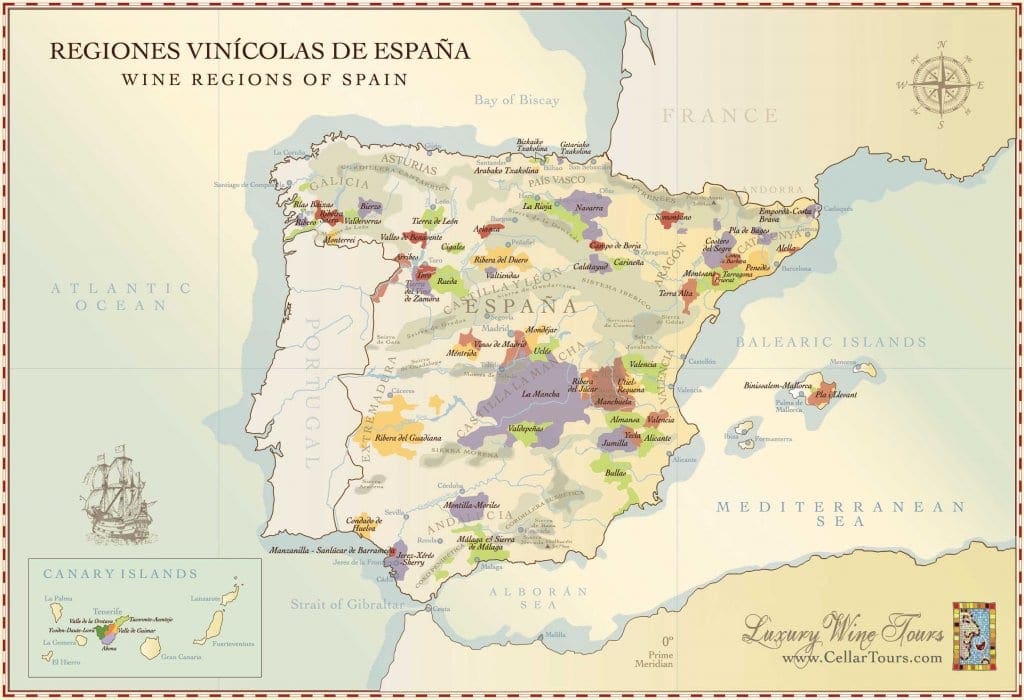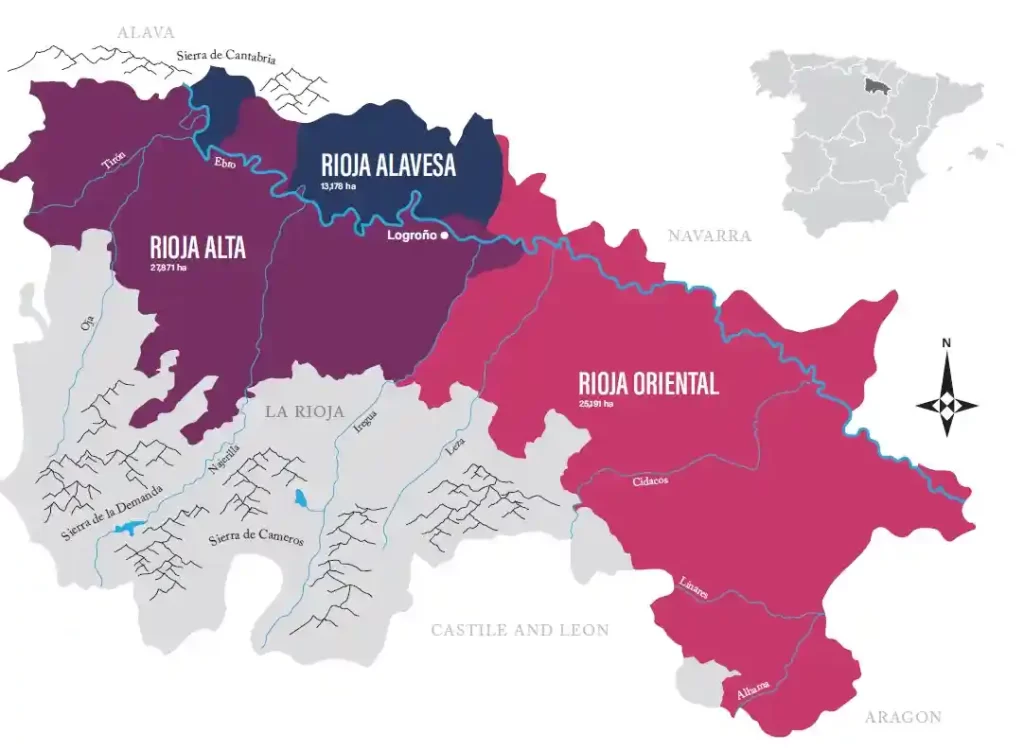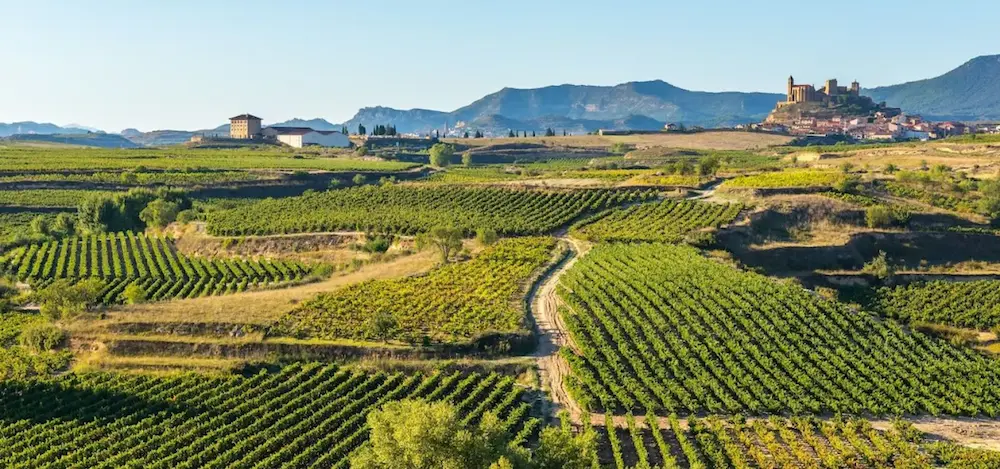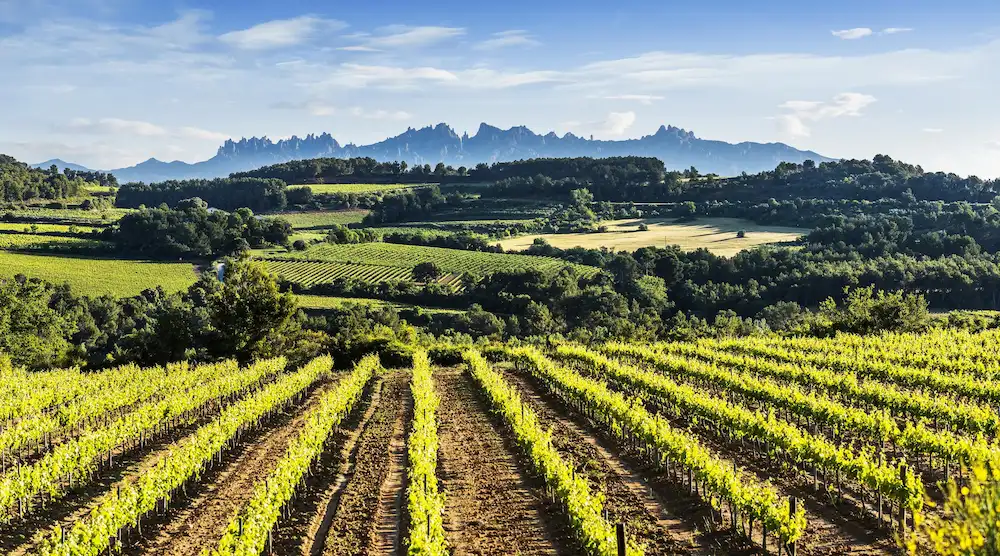Spain is a country divided. Divided by languages, history, culture, football teams, political parties, and climate. There is no one “Spain,” but many overlapping Spains that share the bedrocks of nationhood while differing in the spice—the colourful intricacies that make a place fascinating. One of the most important, and indisputable, divisions—and divisive in that it truly represents a boundary through which things may not pass—is the system of Spanish wine regions. Spain’s wine regions determine what can grow and where, what can be produced and how, and what we drink and why. It’s a system governed by rules, committees, and traditions that answer to no higher authority—where laws segregate grapes and alienate those who dare to exist outside the norms.
But the 70 DOs, 2 DOQs, and numerous VPs and VTs deliver us, the drinkers, an immeasurable service. They tell us what we’re drinking, help us make sense of menus and wine lists, and offer a vessel by which to hitch our Spanish wine expertise—burgeoning or otherwise. So it behooves us to learn something about Spain’s wine regions: what they are, what they mean, why they exist. That way, our journey into Spanish wine can be just a little less blind—and no less adventurous.
What is a Spanish Wine Region, Anyway?
Spain doesn’t just grow wine—it organises it. A wine region in Spain isn’t just a vague area where grapes happen to grow; it’s a legally defined zone with historical, geographical, and cultural meaning. These regions, known officially as Denominaciones de Origen (DOs), draw boundaries around tradition. They tell you what grapes can be planted, how the wine can be made, and even how it can be labelled.
But it’s more than just rules. Each region reflects a unique mix of soil, altitude, climate, and culture—what the French would call terroir (but let’s not get too French about it). A wine from Galicia is going to feel and taste very different to a wine from Andalusia, even if they’re made from the same grape. The regions are like Spain’s many languages—same roots, completely different expressions.
Understanding the regions gives you a map. Not a rigid one, but a useful one. It lets you move from “I like Rioja” to “I like Tempranillo from cooler, higher altitudes with a bit of oak” without sounding like a wanker. It’s about decoding the label, anticipating what’s in the glass, and maybe even choosing with confidence instead of guesswork.
Understanding Spain’s Wine Classification System: DO, DOCa, VP, and More
For a country that sells €3 bottles of wine that actually taste good, Spain sure loves a bit of wine bureaucracy. Behind every label is a spider’s web of rules, regions, and acronyms that can seem like a puzzle box to the uninitiated. But if you crack the code, you unlock a whole new level of wine drinking — one where you can actually know what’s in the bottle before popping it.
Spain has nearly 100 officially recognised wine-producing zones, and they fall into four main quality classifications. The system is vast, sometimes arbitrary, and absolutely everywhere — a DO here, a VP there, a rogue VT lurking in the supermarket aisle. Here’s what it all means, and where it all is:
Denominación de Origen (DO) – 70 Regions and Counting
This is Spain’s bread and butter. There are over 70 DOs, spread across the entire country — from the green, rainy hills of Galicia to the sunburnt plains of Andalusia. Each DO has its own rulebook covering what grapes are allowed, how they’re grown, how the wine is aged, and how it’s labelled.
- Examples: Rías Baixas (Albariño), Rueda (Verdejo), Ribera del Duero (Tempranillo), Penedès (Cava & more).
- Coverage: Most of Spain’s quality wine falls into this category.
Denominación de Origen Calificada (DOCa / DOQ) – Just 2 Elites
This is the “top shelf” tier — reserved for regions with long-standing reputations for excellence and strict internal quality control. Spain has only two DOCa/DOQ regions:
- Rioja (DOCa) – The OG, awarded in 1991. Known for oaked reds and grand tradition.
- Priorat (DOQ) – Catalonia’s bold, rocky rebel, awarded in 2000.
To get this status, a region must have held DO status for at least 10 years and sell its wines at consistently higher prices. It’s prestige backed by paperwork.
Vino de Pago (VP) – Around 20 Exclusive Estates
Literally meaning “estate wine,” this is Spain’s answer to the concept of terroir-driven single vineyards. There are currently around 20 Vinos de Pago, most of them located in regions like Castilla-La Mancha, Valencia, and Navarra. These wines come from individual estates that have proven their land is unique enough to deserve its own micro-designation.
- Examples: Pago de Arínzano (Navarra), Dominio de Valdepusa (Toledo).
- Expect: Boutique producers, smaller volumes, often high prices.
Vino de la Tierra (VT) – 40+ Regions of Freedom
The wildcard category. VT wines come from broader regions than DOs and have fewer restrictions. There are over 40 VTs, including whole regions like Castilla y León, Andalucía, and Baleares, allowing winemakers to experiment with non-traditional grapes or winemaking methods.
- Think: International varieties (Cabernet, Syrah), wild blends, natural wines, and anything that breaks the DO mould.
- Perfect for: Curious drinkers and label-surfers.
Vino de Mesa – The Mystery Bottle
If it’s not part of any official classification, it’s table wine. No region listed, no vintage required, no grape specified. That doesn’t mean it’s bad — but it usually means it’s simple, bulk-produced, and made to be drunk without overthinking it.
- Good for: Topping up the sangria jug or adding to a tomato sauce.
Spain’s system can feel overwhelming at first, but the beauty is this: once you start learning what’s behind those acronyms, the wine list becomes your playground. Want structure and tradition? Look for DOCa. Want to explore? Try a VT or VP. Want to play it safe and still enjoy yourself? A well-made DO wine will rarely steer you wrong.
Spanish Wine Regions at a Glance
Spain has wine regions in almost every corner of the country — from the foggy coast of Galicia to the dusty interiors of Castilla-La Mancha, from the rugged slopes of Priorat to the volcanic soils of the Canary Islands. Some regions are household names (hello, Rioja), while others are better known to locals and wine nerds. Each one has its own personality, preferred grapes, and way of doing things.
Here’s a quick guide to Spain’s most important wine regions — the ones you’ll see most often on wine labels and menus, and the ones worth seeking out on your next Spanish adventure.
Northern Spain
La Rioja (DOCa)
Spain’s best-known wine region, and for good reason. Rioja reds, based mostly on Tempranillo, are known for their age-worthiness, balance, and often oak-driven style. But there’s more here than just tradition — modern Riojas and exciting whites are making waves too.
Here’s our Ultimate Guide to La Rioja.
Navarra (DO)
Sitting just next to Rioja, Navarra is often underrated. It produces excellent rosés (especially from Garnacha), juicy reds, and increasingly fresh, food-friendly whites. Often more experimental and better value than its famous neighbour.
Txakoli (Getariako Txakolina, Bizkaiko Txakolina, Arabako Txakolina – DOs)
These Basque Country DOs are known for light, spritzy, citrusy whites that pair perfectly with pintxos. Made mainly from the Hondarrabi Zuri grape, they’re refreshing and low-alcohol — beach wine, but local.
Galicia (Rías Baixas, Ribeiro, Valdeorras, Ribeira Sacra – DOs)
Rainy, green, and Atlantic-influenced, Galicia is white wine territory. Albariño from Rías Baixas leads the charge, with Godello, Treixadura, and even elegant Mencía reds showing up in other subregions.
Central Spain
Ribera del Duero (DO)
Often framed as Rioja’s bold, brooding sibling. Also Tempranillo territory (locally known as Tinta Fina), but with more power, darker fruit, and less oak-driven elegance. The altitude here gives structure and freshness to big reds that can age beautifully — or knock you sideways young.
Rueda (DO)
Spain’s white wine workhorse, and the home of Verdejo. Fresh, citrusy, slightly herbaceous whites dominate here, with a growing trend towards more textured, serious versions too. Great value, easy to drink, and widely available.
Toro (DO)
Think Ribera del Duero on steroids. Wines here are made mostly from Tinta de Toro, a local clone of Tempranillo, and they are unapologetically big, ripe, and intense. Not for the faint-hearted — but ideal if you like a full-bodied red with a bit of swagger.
Vinos de Madrid (DO)
The capital’s own wine region, surprisingly full of old-vine Garnacha and Albillo Real. A rising star with young winemakers doing exciting things, especially in the Sierra de Gredos mountains just outside the city.
Castilla-La Mancha (Multiple DOs + loads of VPs and VTs) –
The largest wine-producing area in Europe. Often associated with bulk wine, but increasingly home to quality producers making the most of affordable land and old vines. Look for regions like La Mancha DO, Valdepeñas DO, and a number of Vinos de Pago doing boutique work.
Catalonia
Penedès (DO)
One of Spain’s most diverse and dynamic regions, just outside Barcelona. Known mostly for Cava (Spain’s traditional-method sparkling wine), but also a hotbed for still wines made from both local and international varieties. Expect everything from crisp Xarel·lo and mineral Macabeo to experimental natural wines and aromatic reds.
Check out our Ultimate Guide to Penedès here.
Priorat (DOQ)
One of only two DOQs in Spain, and the jewel in Catalonia’s wine crown. Steep, slate-covered hills (locally called llicorella) produce intense, structured reds from Garnacha and Cariñena. These are serious wines — powerful, age-worthy, and often pricey, but worth the splurge.
Montsant (DO)
Priorat’s more affordable neighbour, literally wrapping around it. Montsant offers many of the same grapes and terroirs (Garnacha, Cariñena, and mountainous terrain), but with a softer, more approachable style — and usually a friendlier price tag.
Empordà (DO)
Tucked up in the northeast near the French border, this coastal region is one of Spain’s most underrated. Old-vine Garnacha and Cariñena thrive here, alongside crisp whites and some quirky blends. There’s a wildness to Empordà — in the wind, the wines, and the winemakers — that makes it exciting.
Aragón – The Heartland Around Zaragoza
Campo de Borja (DO)
Often dubbed “The Empire of Garnacha”, this region west of Zaragoza is home to some of Spain’s oldest Garnacha vines. The wines are bold, fruit-forward, and surprisingly affordable. It’s one of the best places to fall in love with Garnacha without breaking the bank.
Cariñena (DO)
One of Spain’s oldest DOs (established in 1932) and named after the Cariñena grape — though nowadays, Garnacha is far more dominant. You’ll find big reds here, often with a rustic charm, and a growing number of modern, polished versions too.
Calatayud (DO)
High-altitude vineyards and extreme temperature shifts make for concentrated reds with freshness and power. Old-vine Garnacha again steals the show, producing wines that are both punchy and elegant, depending on the winemaker’s approach.
Somontano (DO)
Tucked up against the foothills of the Pyrenees, this is Aragón’s wildcard region. While it produces traditional Spanish grapes, it’s also a playground for international varieties like Cabernet Sauvignon, Merlot, and Gewürztraminer. Cooler climate and a spirit of experimentation make Somontano stand out from its Garnacha-heavy neighbours.
Southern Spain
Jerez-Xérès-Sherry (DO)
The legendary home of Sherry, one of the world’s great fortified wines. Made around the town of Jerez de la Frontera in Andalusia, Sherry comes in styles from bone-dry (Fino, Manzanilla) to rich and nutty (Amontillado, Oloroso) to intensely sweet (Pedro Ximénez). It’s complex, traditional, and criminally underappreciated. Once you understand Sherry, you understand Spanish wine at its weirdest and most wonderful.
Málaga & Sierras de Málaga (DOs)
Once famed for sweet, sun-dried wines shipped across Europe, Málaga is making a quiet comeback. In the hills behind the Costa del Sol, producers are rediscovering the potential of old Moscatel vines and high-altitude plantings. Expect a mix of rich dessert wines and fresh, aromatic whites.
Montilla-Moriles (DO)
North of Málaga, this region produces wines similar to Sherry, but often without fortification. Pedro Ximénez is king here — both in sweet, syrupy form and dry, oxidised styles. Less famous than Jerez, but full of hidden gems and extremely food-friendly wines.
Valdepeñas (DO)
Technically in Castilla-La Mancha, but often grouped with the south. Long known for producing masses of Tempranillo (locally called Cencibel) at bargain-basement prices. While much of it is still cheap and cheerful, there are producers upping their game and focusing on quality.
Andalucía VT
Beyond the official DOs, much of southern Spain is covered by the broader Vino de la Tierra de Andalucía designation. This gives producers more freedom to experiment — and there’s a growing number of natural, minimal-intervention, and unorthodox wines coming from these parts.
Eastern Spain & the Mediterranean Coast
Valencia (DO)
A historic port city with a surprisingly diverse wine scene. While much of the region’s production used to focus on bulk wine, it’s now home to vibrant reds from Monastrell and Bobal, as well as zesty whites from Merseguera and Malvasía. The DO itself is split into subzones, each with its own microclimate — inland heat, coastal breeze, and everything in between.
Alicante (DO)
Just south of Valencia, Alicante is a Monastrell powerhouse. The reds here are rich, sun-drenched, and packed with ripe fruit. But look deeper and you’ll find sweet treasures like Fondillón, a rare, aged Monastrell-based dessert wine once favoured by royalty.
Jumilla (DO)
One of Spain’s Monastrell capitals. Located inland between Murcia and Albacete, Jumilla produces concentrated, powerful reds from old vines grown in harsh, dry conditions. It’s also one of the best value-for-money regions in Spain — you can get seriously impressive bottles for not much cash.
Yecla (DO)
Small but mighty. This lesser-known region just north of Jumilla also leans heavily on Monastrell, producing dark, spicy wines that punch above their weight. Many local producers have embraced organic farming, and the wines are often bold but balanced.
Bullas (DO)
The least-known of the Monastrell trio, Bullas is more mountainous and cooler than its neighbours. That altitude brings freshness to its reds, along with a growing number of interesting whites and rosés. Still under the radar, but that’s part of the charm.
The Islands – Balearic & Canary Wine Regions
Mallorca (Binissalem DO & Pla i Llevant DO)
The Balearic Islands may be better known for beaches and clubs, but Mallorca has a long wine tradition. Local grapes like Manto Negro and Callet produce soft, earthy reds, while Prensal Blanc makes fresh, lightly floral whites. These wines often have a Mediterranean soul — ripe, herby, and relaxed — and increasingly organic or natural in style.
Ibiza & Menorca (VT Balears)
No official DOs here, just Vino de la Tierra de Ibiza and Vino de la Tierra de Menorca. These are tiny, boutique scenes where a handful of producers are working with native grapes, international varieties, and natural methods to put island wine back on the map — or at least the beach bar list.
Canary Islands (Multiple DOs)
Volcanic, dramatic, and utterly unique. The Canaries are home to 10 different DOs, spread across islands like Tenerife, Lanzarote, La Palma, and Gran Canaria. The soils are lava. The vineyards often sit on cliffs. And the grape varieties? Wild and ancient — like Listán Negro, Listán Blanco, and Malvasía Volcánica. Wines here can be smoky, salty, and unlike anything else in Spain.
Some of the most exciting natural wine in the country is coming from these islands, where phylloxera never struck and vines grow on their original roots. It’s not just wine — it’s time travel.
Next Steps: Explore Spanish Wine Like a Local
Best Spanish Wine Regions to Visit
If you’re coming to Spain and want to mix wine with wandering, you’re in luck. Many of the country’s top wine regions double as travel destinations — meaning you can drink well and do other things between tastings.
- La Rioja – The classic wine trip. Hilltop towns, flashy architecture (looking at you, Marqués de Riscal), and a ridiculous concentration of wineries. Bonus: many offer tastings in English.
- Penedès – Just outside Barcelona, so easy day trip territory. Cava cellars, vineyard bike rides, modern winemakers, and food pairings galore.
- Priorat & Montsant – Jaw-dropping landscapes, world-class reds, and a proper get-away-from-it-all vibe. You’ll need a car and some good walking shoes.
- Ribera del Duero – More formal and a bit more posh, but you’ll drink seriously good Tempranillo. Many wineries require appointments — worth planning ahead.
- Rías Baixas – For Albariño with a sea breeze. Think wine tasting followed by seafood and an ocean dip.
Best Spanish Wine Regions for Red Wine
If you’re a red wine fan, Spain is basically your playground. The reds range from bold and boozy to elegant and structured, with a grape and region to match every taste.
- Ribera del Duero – Big, bold Tempranillo. Plush fruit, structure, and often a bit of oak polish.
- Rioja – Classic elegance. You can find everything from light and youthful to leather-and-tobacco-aged beauties.
- Priorat – Intense, minerally reds with serious attitude. Garnacha and Cariñena on steroids.
- Toro – Ripe, rustic, high-alcohol reds that pull no punches. Great value for fans of power.
- Jumilla & Yecla – Monastrell country. Spicy, earthy, full-bodied reds that often over-deliver for the price.
Best Spanish Wine Regions for White Wine
Spain might be known for reds, but its whites are some of the most refreshing, food-friendly, and underrated out there.
- Rías Baixas – Home of Albariño: zingy, saline, citrusy, and perfect with seafood.
- Rueda – Verdejo lives here, and when done right, it’s fresh, herbal, and easy to love.
- Valdeorras & Ribeiro – Godello and Treixadura offer a bit more body and complexity.
- Penedès – Great whites made from Xarel·lo, Macabeo, and more — often organic or natural.
- Canary Islands – Volcanic soils = unique whites with smoke, salt, and wild personality.
Underrated Spanish Wine Regions
Everyone knows Rioja and Ribera, but Spain’s got hidden gems tucked into every mountain range and dusty corner. These regions might not get the spotlight, but they’re making killer wines — often for half the price and with none of the tourist crowds.
- Empordà – Catalonia’s northern edge near the French border. Windswept vineyards, old Garnacha vines, and a growing crew of creative winemakers.
- Calatayud – High-altitude Garnacha that punches well above its price. Often rich, spicy, and full of character.
- Valencia – Long dismissed as bulk wine country, now full of energy and experimentation. Bobal, Monastrell, and native white grapes are thriving.
- Bullas – Cooler than neighbouring Jumilla, with surprisingly elegant reds and a natural wine undercurrent.
- Vinos de Madrid – The wine region nobody expects. Old vines, mountain vineyards, and a short train ride from the capital.
These places are where you’ll find the “I paid €9 for this and it blew my mind” wines.
How to Read a Spanish Wine Label
Spanish wine labels are like puzzles — they make more sense once you know what to look for. Here’s a cheat sheet for decoding them like a pro:
- Region First – Most bottles list the region (e.g. Rioja, Rueda, Ribera del Duero) loud and proud. That tells you the grape, style, and often the ageing.
- Grape? Maybe. – Some DOs allow grapes on the label (e.g. Verdejo in Rueda), others don’t (Rioja reds are almost always Tempranillo, but rarely say so).
- Ageing Terms
- Joven: young, fresh, usually no oak
- Crianza: minimum ageing (often 2 years total, 1 in oak for reds)
- Reserva: more age, more complexity
- Gran Reserva: the old-school stuff — aged for years before release
- Classification Clues – Look for DOCa, DO, VT, or VP to know the wine’s tier.
- Producer & Bottler Info – “Embotellado en la propiedad” means estate bottled — a good sign.
Once you get the hang of it, labels go from confusing to empowering — suddenly you’re making informed choices, not just picking by price and pretty fonts.
Spanish Wine Road Trips & Experiences
If sipping wine in situ is your thing, Spain delivers. You can turn your next holiday into a moving wine tasting — with some epic food, scenery, and hangovers along the way.
- Barcelona → Penedès → Priorat – Beach to bubbles to bold reds. A perfect 3–4 day loop with great food stops and stunning views.
- Madrid → Vinos de Madrid → Gredos Mountains – Taste in the capital, then head into the hills for old-vine Garnacha and cool-climate magic.
- Santiago de Compostela → Rías Baixas → Ribeiro – Spiritual journey meets seafood and Albariño. End at the coast with a bottle and a plate of pulpo.
- Jerez → Sanlúcar → Cádiz – Sherry, sea breezes, fried fish, and flamenco. A sensory overload in the best possible way.
- Logroño → Rioja Alta → Rioja Alavesa – Classic wine country. Rent bikes, eat your weight in pintxos, and taste your way through wine history.
Pro tips:
- Always call ahead for tastings.
- Take public transport where possible, or book a tour (like ours 😏).
- Never be afraid to spit — but also, you’re on holiday.
Natural, Organic & Biodynamic Wines in Spain
Spain might have an old-school reputation, but it’s also one of the most exciting places in Europe for natural, organic, and low-intervention wines. Why? Because it has everything you need: sunshine (less need for chemical intervention), old vines (deep roots = complexity), and rebellious winemakers who are sick of playing by the DO rulebook.
- Catalonia – Especially around Penedès, Empordà, and the outskirts of Priorat. Loads of natural producers here doing funky things with Xarel·lo, Garnacha, and more. Some are within the DOs, but many go rogue and bottle as Vino de la Tierra or table wine.
- Canary Islands – Volcanic soils, pre-phylloxera vines, and wild terrain. You’ll find salty whites and smoky reds made with little more than grapes and guts. Tenerife in particular is a hotspot for natural winemakers.
- Sierra de Gredos (Vinos de Madrid & beyond) – A mountainous region west of Madrid where old-vine Garnacha thrives on granite soils. The wines are light, perfumed, and often made with minimal sulphur and intervention. This area has developed a cult following among sommeliers and natural wine lovers.
- Galicia – Not just for crisp Albariño. There’s a quiet natural wine movement happening in the misty hills of Ribeira Sacra and Valdeorras, especially with Godello and Mencía.
- Castilla-La Mancha – Surprisingly, yes. Thanks to cheap land and old bush vines, many young producers are setting up shop here and experimenting outside the DO system. You’ll find funky labels, wild fermentations, and wine with attitude.
If you’re looking for wines with a bit of haze, a lot of honesty, and maybe a few surprises — Spain’s new wave is where it’s at.





